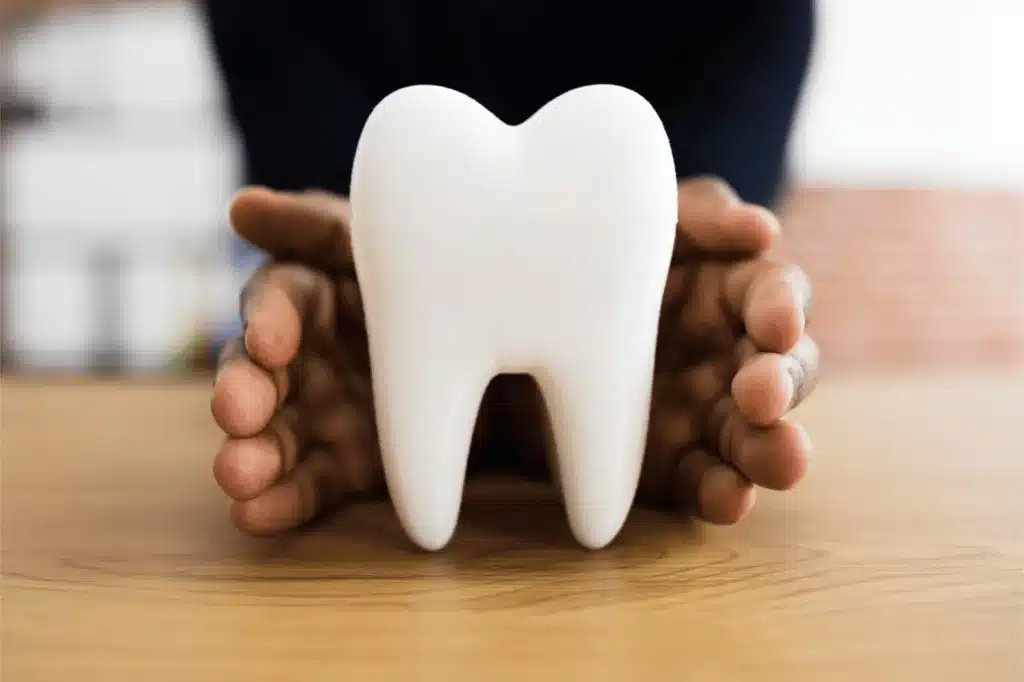Learn ways to protect tooth enamel and avoid the harmful consequences of its erosion. Read to explore the causes of tooth enamel erosion and ways to prevent your teeth from damage.
What is Tooth Enamel?
Tooth enamel is the resilient outer layer of your teeth, often hailed as the hardest substance in the human body. Composed primarily of hydroxyapatite, a crystalline structure rich in minerals, it forms a protective shield over the inner layers of your teeth.
Role of Enamel in Oral Health
Enamel plays a pivotal role in maintaining oral health. It acts as a barrier, safeguarding the inner tooth layers from the wear and tear of daily use. Moreover, it shields against temperature extremes and acidic attacks from foods and beverages.
Structure and Composition of Enamel
Enamel is a complex structure with a unique composition. Its dense mineral matrix gives it strength, while its semi-translucent nature allows the underlying dentin layer’s color to show through. Understanding enamel’s intricate makeup underscores its significance in preserving dental health.
Consequences of Enamel Erosion
How Enamel Erosion Occurs
Enamel erosion occurs when acids from various sources, such as acidic foods, beverages, or even stomach acids from conditions like acid reflux, erode the protective enamel layer. This process weakens and thins the enamel, making it more susceptible to damage.
Sensitivity and Pain
As enamel erodes, it exposes the sensitive dentin beneath, leading to increased tooth sensitivity. You may experience discomfort when consuming hot, cold, sweet, or acidic substances. In advanced cases, this sensitivity can progress to pain, impacting your daily life.
Increased Risk of Cavities
Enamel erosion significantly raises the risk of cavities. With the protective enamel layer compromised, bacteria can penetrate deeper into the tooth structure, leading to decay. Cavities, if left untreated, can result in more extensive dental problems.
Cosmetic Concerns
Beyond functional issues, enamel erosion can have cosmetic consequences. Teeth may appear discolored, stained, or translucent, diminishing the aesthetic appeal of your smile. Cosmetic concerns can affect your confidence and self-esteem.
Ways to Protect Tooth Enamel
Let’s explore some ways to protect tooth enamel from damage.
Maintain Good Oral Hygiene
- Brushing Techniques for Enamel Protection: When it comes to preserving your enamel, the way you brush matters. Choose a soft-bristle toothbrush and gentle, circular motions to avoid abrasive damage. Brush for a full two minutes, ensuring thorough coverage.
- Importance of Using Fluoride Toothpaste: Select a toothpaste with fluoride, a mineral renowned for its enamel-strengthening abilities. Fluoride helps rebuild weakened enamel and fortify it against acids and decay.
Diet and Nutrition
- Foods that Promote Enamel Health: Incorporate enamel-friendly foods such as dairy products, leafy greens, and nuts into your diet. These foods provide essential minerals like calcium and phosphorus, which are crucial for enamel resilience.
- Foods to Limit or Avoid: Minimize your consumption of acidic foods and sugary beverages. Acidic substances erode enamel over time, while sugars feed harmful bacteria that produce enamel-damaging acids. It’s one of the best ways to protect tooth enamel.
Stay Hydrated
- Role of Saliva in Enamel Protection: Saliva is your mouth’s natural defense mechanism. It helps neutralize acids, remineralize enamel, and maintain a healthy pH balance. Stay well-hydrated to ensure your saliva can do its job effectively.
Avoid Acidic Beverages and Habits
- Impact of Acidic Drinks on Enamel: Acidic beverages like sodas, citrus juices, and energy drinks can erode enamel over time. Consume them sparingly, and consider using a straw to minimize contact with your teeth.
- Quitting Harmful Habits like Smoking: Smoking stains teeth and increases the risk of gum disease, which can lead to enamel erosion. Quitting smoking is a crucial step in protecting your enamel.

Regular Dental Check-ups
- Importance of Professional Cleanings: Professional dental cleanings are one of the ways to protect tooth enamel. Dental cleanings remove plaque and tartar buildup, which can contribute to enamel erosion. These cleanings also allow your dentist to assess your enamel’s health.
- Early Detection and Prevention of Enamel Erosion: Regular dental check-ups allow early detection of enamel issues. Your dentist can recommend preventive measures and treatments to safeguard your enamel.
Implementing these ways to protect tooth enamel as part of your daily routine can go a long way in preserving your smile’s strength and vitality.
Enamel-Friendly Habits
Let’s explore enamel-friendly ways to protect tooth enamel from damaging and maintain dental health.
Maintaining a Balanced Diet
A balanced diet isn’t just good for your waistline; it’s crucial for the health of your teeth. Incorporate enamel-strengthening foods like dairy products, leafy greens, and lean proteins into your meals. These nutrient-rich choices provide calcium and phosphorus, the building blocks of solid enamel.
Proper Techniques for Tooth Brushing
Brushing your teeth is a daily ritual, and doing it right matters. Opt for a soft-bristle toothbrush and use gentle, circular motions to prevent abrasive damage to your enamel. Be thorough, ensuring every tooth gets the attention it deserves during your two-minute brushing routine.

Drinking Water Throughout the Day
Water isn’t just refreshing; it’s an ally in enamel protection. Drinking water helps maintain a healthy pH balance in your mouth and promotes saliva production. This natural defense mechanism assists in neutralizing acids and remineralizing your enamel.
Dental Check-ups
Regular dental check-ups are the cornerstone of lifelong enamel protection. These appointments allow your dentist to monitor your enamel’s health, remove plaque and tartar buildup, and catch any early signs of erosion.
Conclusion
Exploring ways to protect tooth enamel becomes compulsory in maintaining oral health and a radiant smile. Tooth enamel and its erosion consequences can damage your oral health. Follow preventive instructions to protect the dental shield.


